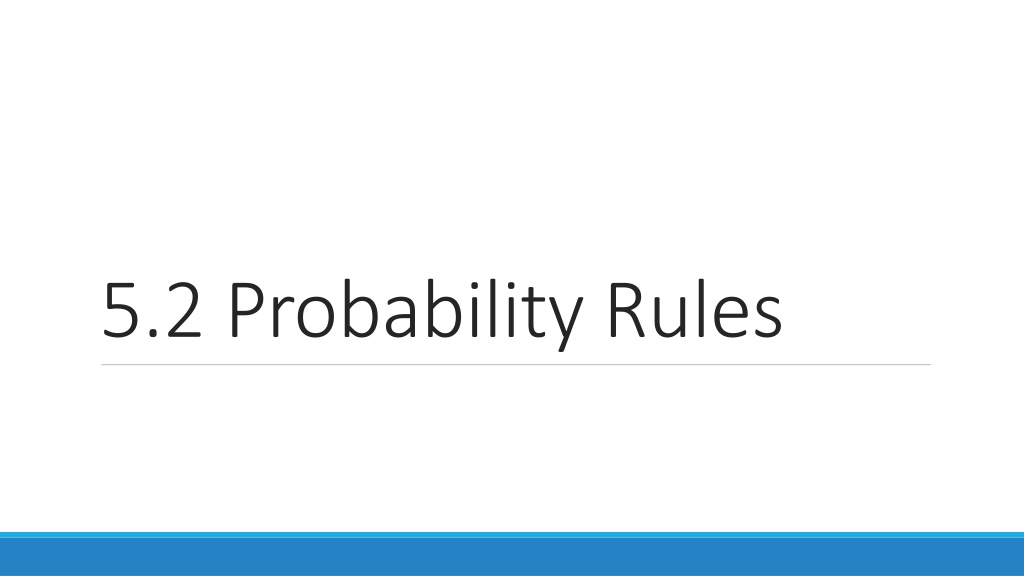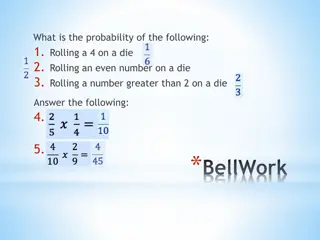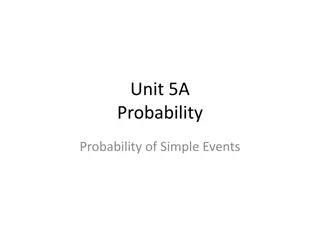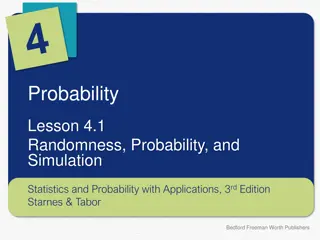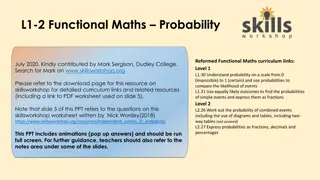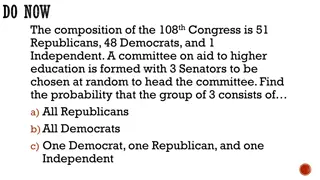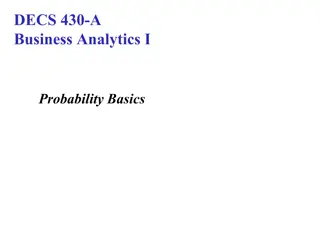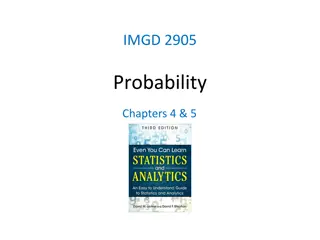Understanding Probability Rules and Models
Probability rules and models explain how to calculate the likelihood of different outcomes in a chance process by utilizing sample spaces, probability models, events, and basic rules of probability. Learn about the importance of sample space, probability models, calculating probabilities, mutually exclusive events, and more to enhance your understanding of probabilities.
Download Presentation

Please find below an Image/Link to download the presentation.
The content on the website is provided AS IS for your information and personal use only. It may not be sold, licensed, or shared on other websites without obtaining consent from the author. Download presentation by click this link. If you encounter any issues during the download, it is possible that the publisher has removed the file from their server.
E N D
Presentation Transcript
Sample Space and Probability Model Sample Space and Probability Model The sample space S of a chance process is the set of all possible outcomes. Example: Experiment: rolling a die: Sample space = {1,2,3,4,5,6} A probability model is a description of some chance process that consists of two part: a sample space S and the probability for each outcome. The sum of all of the probabilities for the sample space = 1. Double check your answers! For example: When a fair 6-sided die is rolled, the Sample Space is S = {1, 2, 3, 4, 5, 6}. The probability for a fair die would include the probabilities of these outcomes, which are all the same. Outcome 1 2 3 4 5 6 Probability 1/6 1/6 1/6 1/6 1/6 1/6
EX2 EX2: Imagine flipping a fair coin three times. Give the probability model for this chance process. HHH HHT HTH HTT TTT TTH THT THH 1/8 1/8 1/8 1/8 1/8 1/8 1/8 1/8
Event An event is any collection of outcomes from some chance process. That is, an event is a subset of the sample space. Events are usually designated by capital letters, like A, B, C, and so on. For example: For the probability model above we might define event A = die roll is odd. The elements of the sample space S that fits this event are {1, 3, 5}. The probability of the event A, written as P(A) is the 3/6 or . So we would write P(A) = 0.5, in decimal form.
The Basic Rules of Probability For any event A, 0 P(A) 1. If S is the sample space in a probability model, P(S) = 1. In the case of equally likely outcomes, P(A) = number of outcomes corresponding to event A total number of outcomes in sample space Complement rule: The complement of event A (written as AC) is the event that A does not occur, and P(AC) = 1 P(A) Addition rule for mutually exclusive events: If A and B are mutually exclusive, P(A or B) = P(A) + P(B).
Mutually Exclusive Events Mutually Exclusive Events Two events A and B are mutually exclusive (or disjoint) if they have no outcomes in common and so can never occur together that is, if P(A and B ) = 0. For example: Using a deck of playing cards and drawing a card at random, the events A = card is a King, and B = card is a Queen are mutually exclusive because a single card cannot be both a King and a Queen. Thus we can calculate the probability of A or B as the sum of their individual probabilities P(A or B) = 4/52 + 4/52 = 8/52 or 2/13.
Multiplication Principle If you can do one task N number of ways and a second task M number of ways, then both tasks can be done in NxM number of ways. EX: If I have 3 shirts, 2 pairs of pants and 4 hats, how many different outfits could I wear? Independent Events Two events are independent if knowing one occurs does not change the probability of the other occurring. (i.e. flipping a coin, rolling a die, drawing a card with replacement) The Multiplication Rule for Independent Events If A and B are independent events, then the probability that A and B both occur is P(A B) = P(A) P(B) And means multiply Or means add
EX3: Women aged 25-39 are chosen at random and asked their marital status, and the data is recorded. Marital Status Never Married Probability Married 0.574 Widowed 0.002 Divorced 0.071 0.353 Find the following probabilities. a. P(not married) = ? ????? + ? ??????? + ?(????????) = .353 + .002 + .071 = .426 1 ? ??????? = 1 .574 = .426 a. P(never married or divorced) = ? ????? + ?(????????) = .353 + .071 = .424
EX4: Social classes are ordered from 1(lowest) to 5(highest). Below are probabilities that the son of a father from Class 1 will end up in each class. 1 2 3 4 5 Son s Class Probability 0.48 0.38 0.08 0.05 0.01 A = {son remains in Class 1} B = {son reaches one of two highest classes} a. What is the probability that the son does not end up in Class 1? 1 ? ? = 1 .48 = .52 b. What is the probability that the son remains in Class 1 or reaches one of the two highest classes? ? ? + ? ? = .48 + .05 + .01 = .54
EX5: a. From a deck of cards you wish to draw a heart, and then an ace. Find the probability of this occurring with replacement. ? ???? ??? ??? = ? ???? ? ??? 13 52 To reduce fractions, use math, enter, enter on your calculator 4 52 1 52 = = a. From a deck of cards you wish to draw a heart, and then another heart. Find the probability of this occurring without replacement. ? ???? ??? ???? ?? ???? = ? ???? ? ???? ?? ???? 13 52 12 51 1 17 = =
EX6:A telephone cable contains repeaters at regular intervals to amplify the signal. Each repeater has a probability of 0.999 of functioning without failure for ten years. Repeaters fail independently of each other. a. Find the probability that two repeaters both last ten years. ? ??? ???? = .999 .999 = .998 a. Find the probability that a cable with ten repeaters has no failures in ten years. = .999 .999 .999 ?? .99910= .990 ? ??? ???? Find the probability that a cable with ten repeaters has at least one failure. ? ?? ????? ??? ???? = ? 1 + ? 2 + ? 3 + ? 4 + ? 5 + ? 6 + ? 7 + ? 8 + ? 9 + ?(10) OR ? ?? ????? ??? ???? = 1 ?(0) = 1 ? 10 ???? = 1 .990 = .01
EX7: The following table gives the favorite subject by gender: Subject Math Science English Other Total Male 15,802 3,262 3,822 1,571 24,457 Female 2,367 2,233 856 571 6,027 Totals 18,169 5,495 4,678 2,142 30,484 Find the probability that a randomly selected person a) likes science 5495 30484= .18 General Addition Rule If A and B are any two events resulting from some chance process, then P(A or B) = P(A) + P(B) P(A and B) a) is female 6027 30484= .198 2233 30484= .073 a) is female and likes science 5495 30484+ 6027 30484 2233 30484= .305 a) is female or likes science Double counted
Venn Diagrams and Probability The complement Ac contains exactly the outcomes that are not in A. The events A and B are mutually exclusive (disjoint) because they do not overlap. That is, they have no outcomes in common. The union of events A and B (A B) is the set of all outcomes in either event A or B. The intersection of events A and B (A B) is the set of all outcomes in both events A and B.
EX8: Zach has applied to both Princeton and Stanford. He thinks that the probability that Princeton will admit him is 0.4, and Stanford is 0.5, and both is 0.2. a. Make a Venn diagram to illustrate these probabilities. P S b. What is the probability that either Princeton or Stanford admits Zach? .2 + .2 + .3 = .7 .2 .2 .3 c. What is the probability that neither admits him? . 3 .3 d. What is the probability that he gets into Stanford, but not Princeton? .3
EX9: Matt and Deborah are up for a promotion to partner at their law firm. a. Draw a Venn diagram and shade to find the following: M = {Matt making partner} D = {Deborah making partner} i. P(M and D) = M iv. P(DC and M) = P(D) = 0.7 P(M) = 0.5 P(M and D) = 0.3 D M D .3 .2 i. P(M or D) = M v. P(DC and MC) = D M D M D .9 .1 .4 .2 .3 i. P(D and MC) = M .1 D .4
EX10: 39% of US households own at least one dog, and 34% of US households own at least one cat. Assume that 60% of households own a dog or cat. Use the probability rules to test the notion that owning a dog and owning a cat are independent events. ? ??? ?? ??? = ? ??? + ? ??? ?(??? ??? ???) The Multiplication Rule for Independent Events If A and B are independent events, then the probability that A and B both occur is P(A B) = P(A) P(B) .6 = .39 + .34 ?(??? ??? ???) .13 = ?(??? ??? ???) ? ??? ??? ??? = ? ??? ?(???) .13 = .39 (.34) .13 .1326
EX11: In a survey of 20 people: 11 like Pizza Hut 9 like Subway 12 like Burger King 9 like Pizza Hut and Burger King 3 like Subway and Pizza Hut 5 like Subway and Burger King 3 like all of them 0 4 2 3 2 6 1 2 a. How many just like Burger King? Burger King 1 b. How many like Pizza Hut and Subway, but not Burger King? 0 c. How many like none of these? 2
